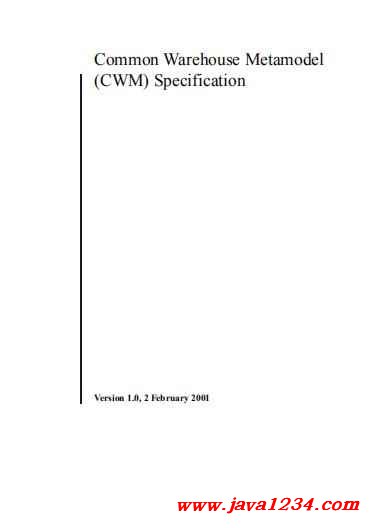| 失效链接处理 |
|
Common warehouse metamodel PDF 下载
本站整理下载:
相关截图:

主要内容:
1.1 Co-submitting Companies and Supporters
The following companies are co-submitters of the Common Warehouse Metamodel
specification (hereafter referred to as CWM):
• International Business Machines Corporation
• Unisys Corporation
• NCR Corporation
• Hyperion Solutions Corporation
• Oracle Corporation
• UBS AG
• Genesis Development Corporation
• Dimension EDI
The following companies are supporters of CWM:
• Deere & Company
• Sun Microsystems Inc.
• Hewlett-Packard Company
• Data Access Technologies
• InLine Software
• Aonix
• Hitachi, Ltd
• SAS Institute Inc.
• Meta Integration Technology, Inc.
1-18 CWM 1.0 2 February 2001
1 • Adaptive Ltd
• Cognos Inc.
1.2 Introduction
The main purpose of CWM is to enable easy interchange of warehouse and business
intelligence metadata between warehouse tools, warehouse platforms and warehouse
metadata repositories in distributed heterogeneous environments. CWM is based on
three key industry standards:
• UML - Unified Modeling Language, an OMG modeling standard
• MOF - Meta Object Facility, an OMG metamodeling and metadata repository
standard
• XMI - XML Metadata Interchange, an OMG metadata interchange standard
These three standards form the core of the OMG metadata repository architecture as
illustrated in Figure 1-1.
The UML standard defines a rich, object oriented modeling language that is supported
by a range of graphical design tools. The MOF standard defines an extensible
framework for defining models for metadata, and providing tools with programmatic
interfaces to store and access metadata in a repository. The XMI standard allows
Figure 1-1 OMG Metadata Repository Architecture
OMG Metadata Repository Architecture
Object Request Broker (ORB)
Object Services
UML MOF XMI
Repository Common Facility
Tools and
Repositories
2 February 2001 CWM 1.0 1-19
1
metadata to be interchanged as streams or files with a standard format based on XML.
The complete architecture offers a wide range of implementation choices to developers
of tools, repositories and object frameworks. XMI in particular lowers the barrier to
entry for the use of OMG metadata standards.
Key aspects of the architecture include:
• A four layered metamodeling architecture for general purpose manipulation of
metadata in distributed object repositories. See the MOF and UML specifications
for more details
• The use of UML notation for representing metamodels and models
• The use of standard information models (UML) to describe the semantics of object
analysis and design models
• The use of MOF to define and manipulate metamodels programmatically using fine
grained CORBA interfaces. This approach leverages the strength of CORBA
distributed object infrastructure.
• The use of XMI for stream based interchange of metadata
This specification mainly consists of definitions of metamodels in the following
domains:
• Object model (a subset of UML)
• CWM foundation
• Relational data resources
• Record data resources
• Multidimensional data resources
• XML data resources
• Data transformations
• OLAP (On-line Analytical Processing)
• Data mining
• Information visualization
• Business nomenclature
• Warehouse process
• Warehouse operation
This specification defines these metamodels and provides proof of concept that covers
key aspects of CWM. The specification represents the integration of work currently
underway by the submitters and supporters in the areas of warehouse metadata
management in distributed object environments. The submitters intend to
commercialize the CWM technology within the guidelines of the OMG.
The adoption of the UML and MOF specifications in 1997 was a key step forward for
the OMG and the industry in terms of achieving consensus on modeling technology
and repositories. The adoption of XMI in 1999 reduced the plethora of proprietary
|




 苏公网安备 32061202001004号
苏公网安备 32061202001004号



